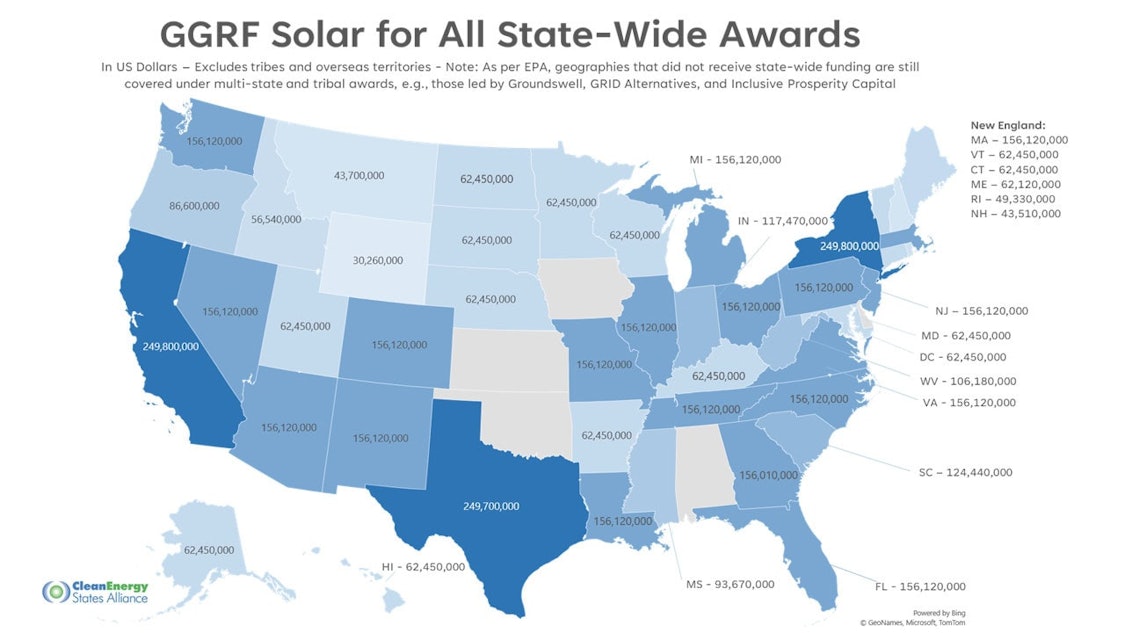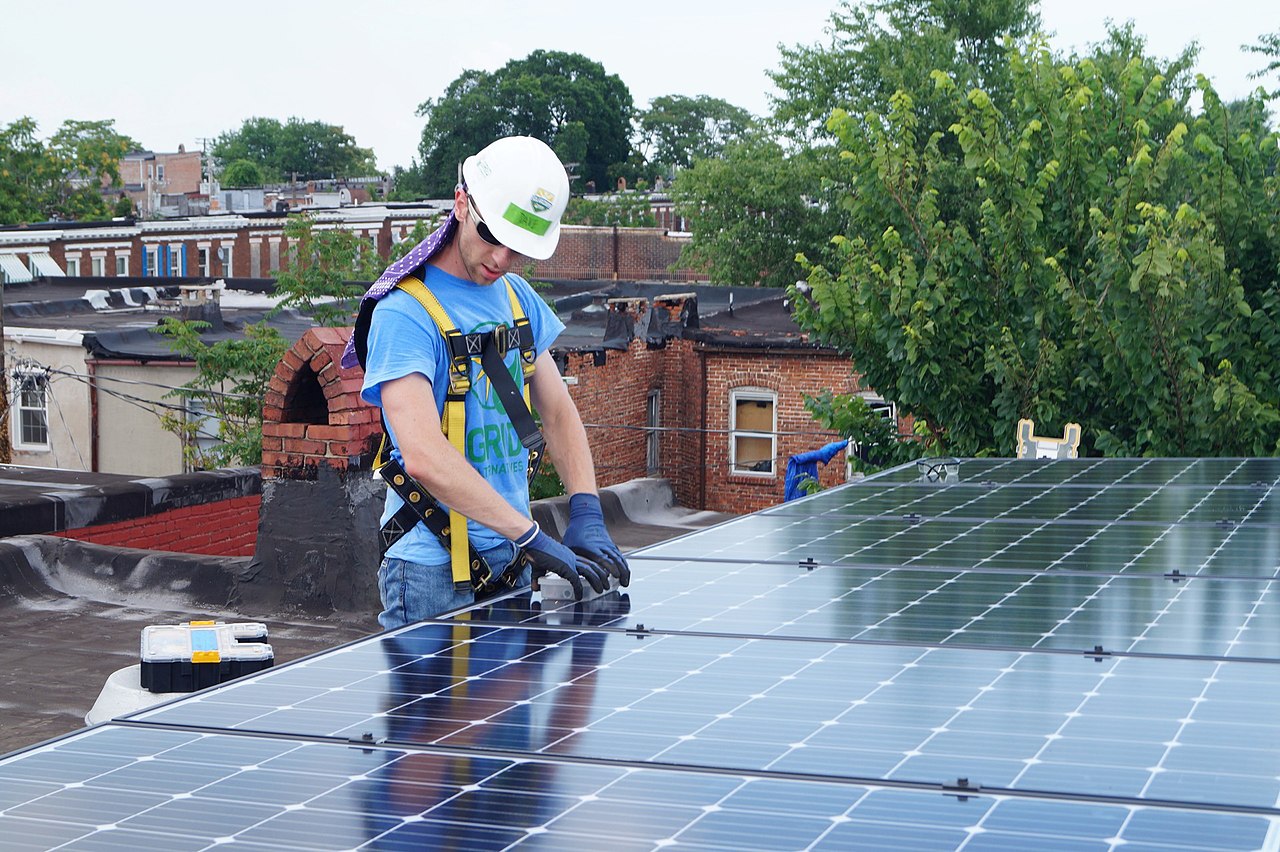Iowa was among just five states that did not receive statewide funding through the U.S. Environmental Protection Agency’s $7 billion Solar for All Program, designed to deliver residential solar power to some 900,000 households across the country. The 60 federal grants announced on April 22 will focus on “long-lasting solar programs” targeting “low-income and disadvantaged communities.”
The Iowa Economic Development Authority did not comment on why the EPA declined to fund the state’s application for $75 million through the competitive grant program. Critics noted the state’s “utility-driven approach,” which did not include labor unions or registered apprenticeship programs.
A RECORD INVESTMENT IN RESIDENTIAL SOLAR
Solar for All, the largest ever federal program to expand residential solar, is one of several EPA initiatives funded through the Inflation Reduction Act. Then U.S. Representative Cindy Axne was the only Iowan to vote for that legislation, which Congress approved and President Joe Biden signed in August 2022.
The Clean Energy States Alliance created this map to illustrate the statewide Solar for All awards announced last month. Four of Iowa’s border states will each receive $62.45 million. Illinois and Missouri will receive $156.12 million each. Most of the “benchmarked states” used for comparison in Governor Kim Reynolds’ state government reorganization plan last year will also receive tens of millions of dollars. Only Iowa, Kansas, Oklahoma, Alabama, and Delaware failed to land statewide funding.

An unknown number of Iowans could gain access to residential solar installations through two multi-state nonprofit projects that received Solar for All awards. GRID Alternatives mentioned Iowa and 28 other states in its application, which was awarded $249.8 million. Inclusive Prosperity Capital, Inc. mentioned Iowa and 46 other states in its proposal, which will receive $249.3 million.
WHERE IOWA’S APPLICATION FELL SHORT
The Iowa Economic Development Authority’s $75 million proposal laid out a five-year plan to develop an Iowa Community Solar Program, with goals of installing 103 megawatts of solar and adding 3.5 megawatt-hours of storage capacity to benefit 12,000 households. The application materials estimated the program would save Iowa households $80.4 million over 20 years, while avoiding 165,710 short tons of CO2 emissions annually.
One apparent problem was Iowa’s focus on community solar projects, rather than distributed generation such as residential solar installations. When announcing the grants last month, the EPA noted that 90 percent “of selected applicants plan to fund residential rooftop solar,” while 88 percent “plan to fund the deployment of residential-serving community and shared solar through diverse ownership models that enable households in disadvantaged communities to access the additional economic benefits of asset ownership.”
Josh Mandelbaum, senior attorney for the Environmental Law & Policy Center, sees the Solar for All grant as “another example of how the failed approach of the Reynolds Administration and Iowa utilities has caused the state to lose out on tens of millions of dollars of funding to support the clean energy transition.” He told Bleeding Heartland,
As a state, we have been slow to develop a framework for community solar generally, and distributed and low-income community solar in particular. Rather than use this program as an opportunity to catch up to leading states and develop a strong policy framework, the Iowa application adopted a utility-driven approach that would not create a pathway for solar deployment beyond the grant. If Iowa does not want to lose its place as a clean energy leader and lose out on high quality clean energy jobs, this should serve as a wake-up call to change our approach.
Samantha Groark, executive director of the Central Iowa Building & Construction Trades Council, likewise observed via email that the funds Iowa missed out on could have “strengthened the state’s energy workforce” in addition to fighting climate change. She noted, “Davis-Bacon (prevailing wage) protections would have applied to the building and construction work performed under the grant, which could have meant more high-quality, family-sustaining jobs for Iowans.”
Groark also criticized Iowa’s approach to the grant.
Upon reviewing highlights from the applications of states that were successful, it appears that at least one thing Iowa was lacking in its proposal was inclusion of labor unions and building trades councils, and recognition of the state’s existing registered apprenticeship training programs. It isn’t apparent to the Iowa State Building & Construction Trades Council or its regional affiliates and labor union membership that any effort was made on the part of the state to partner on the application or garner any letters of support, which could have bolstered Iowa’s chances. In its packet of letters, there are noticeably none from building trades unions.
Guidance from EPA grant evaluation materials stated that applicants were encouraged to submit letters of support from, among many groups, “unions” and “worker centers.” They did not. In fact, they only received one letter of support associated with any registered apprenticeship program or workforce training program: the small Meskwaki Tribe apprenticeship.
The EPA made clear that grant applications should make commitments to strong labor standards, including utilization of registered apprenticeship programs, prevailing wages, and partnerships with labor organizations and community-based groups.
Groark found it troubling that the state “proposed creating new state-driven registered apprenticeships and job classifications” through Iowa Workforce Development’s new Iowa Office of Apprenticeship, instead of involving existing solar training programs. She added, “There are hardworking men and women working on solar projects all across Iowa right now, including members of building trades unions that take great pride in their training and quality of work. Iowa’s desire as stated in its application that the state would simply provide government funds to businesses to create new training programs seems to be off the mark, and apparently the EPA agreed.”
Andrew Johnson, executive director of the Clean Energy Districts of Iowa, had a different take. He thanked the employees of the State Energy Office (part of the Economic Development Authority) for putting in significant time and energy on Iowa’s application. “They reached out to partners across the state to come up with an approach that, however imperfect, held real promise for expanding solar access to lower-income households throughout Iowa,” he told Bleeding Heartland.
Johnson credited the Biden administration and EPA for the Inflation Reduction Act, but he thinks the federal government “dropped the ball” in rejecting Iowa’s Solar for All application. “I’m not privy to their reasoning,” he added, but since Solar for All funding was meant for states (unlike the EPA’s other two Greenhouse Gas Reduction Fund programs), Johnson feels “they should have held true to the intent of the program and funded every state that applied, even if they wanted to hold some funds for non-profit entities as well.”
Clean Energy Districts of Iowa still hope “significant” funds will come to Iowa, Johnson said, through the GRID Alternatives and Inclusive Prosperity Capital awards mentioned above.
We should also note that Iowa doesn’t need to rely on federal funds to help bring solar prosperity to households across the state. Passing a version of community solar and/or virtual net metering such as what stalled in the legislature this session, and requiring the utilities to support community solar subscriptions for low-income households within our ratepayer-funded energy efficiency and demand response programs, are just two approaches that could benefit households in every county in the state.
In 2023, Iowa was one of just four states not to apply for a $3 million planning grant under the EPA’s Climate Pollution Reduction Grants program, another Inflation Reduction Act initiative. Des Moines, Cedar Rapids, and Iowa City later applied for smaller planning grants under that program. The Des Moines metro area’s resulting plan to reduce greenhouse gas emissions is available here, and the same document for East Central Iowa (covering counties in and around the Cedar Rapids/Iowa City metro) is here.
Top image: “Dave, a Solar Installation Supervisor working at GRID Alternatives Mid-Atlantic, inspects the solar panels after installing for a low-income family in Baltimore, Maryland.” Kirsten Rumsey took the photo for the U.S. Department of Energy on July 6, 2016. Originally posted on Flickr, available via Wikimedia Commons.


6 Comments
We are not good at getting these federal awards.
We also didn’t get any award for the CHIPS Act’s manufacturing incentive. $30 billions have been awarded this April to 10 other States.
Karl M Mon 6 May 4:34 PM
I'm squinting hard at that map...
…and am still not seeing something, because I only see Iowa, Oklahoma, Kansas, and Alabama as the no-funding states. I’m probably missing something obvious, and thanks in advance for further info.
PrairieFan Mon 6 May 4:55 PM
Delaware also didn't receive statewide funding
The full list of 60 awards can be found here:
https://www.epa.gov/greenhouse-gas-reduction-fund/solar-all
Laura Belin Mon 6 May 6:08 PM
I added a sentence
to make clear that Delaware was the fifth state shut out from this grant program.
Laura Belin Mon 6 May 6:23 PM
Thank you!
That”ll teach me to squint better. I should have seen that Delaware is very pale.
PrairieFan Mon 6 May 10:03 PM
Now to get the Utilities on board!
We have had solar for 4 years and one would think (in fact, it was part of the sales pitch for the panels) that we would be net metered with MidAmerican Energy: that what you are charged per kWh is what you are credited with, if one generated an excess amount. This is NOT true.
MidAmerican gives us only 27% back of their original rate. Then, to further insult us, half of that is taken for an I Care allocation. So, yeah, we get 13.5% back. And are busy looking at additional ways to use more of our own solar generated electricity. Underfloor heating was added to the bathroom a few years ago but still need more usage!
quadtodd Thu 9 May 7:15 PM